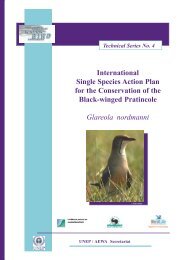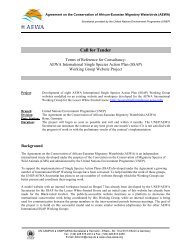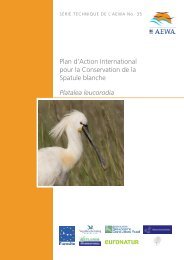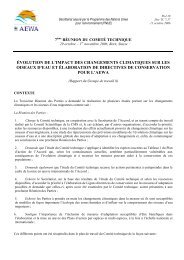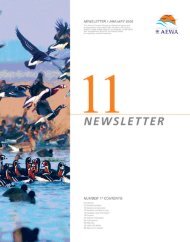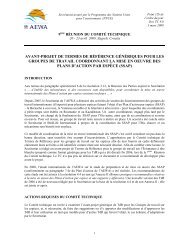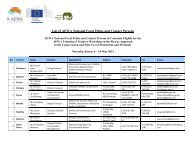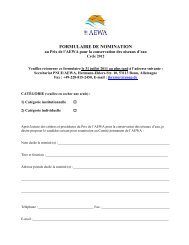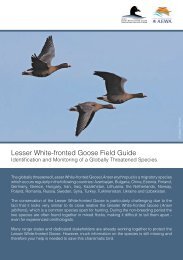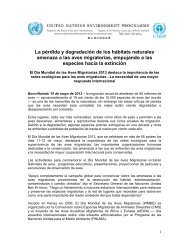International Single Species Action Plan for the ... - AEWA
International Single Species Action Plan for the ... - AEWA
International Single Species Action Plan for the ... - AEWA
You also want an ePaper? Increase the reach of your titles
YUMPU automatically turns print PDFs into web optimized ePapers that Google loves.
<strong>AEWA</strong> Technical Series No. 36 - Annexes<br />
sometime soon after this date, as <strong>the</strong> next transmission, on 26 March, was from Dagestan, in<br />
sou<strong>the</strong>rnmost Russia. During its stay of almost four months in Iraq <strong>the</strong> bird was recorded<br />
primarily from <strong>the</strong> lakes/wetlands and lowlands of <strong>the</strong> Tigris river basin (see Map 2).<br />
Map 2. Locations of satellite-tracked Lesser White-fronted Goose in Iraq, November<br />
2004 to March 2005. The three locations marked Haur Al Shubaicha, Haur Al Suwayqiyah<br />
and Haur Chubaisah are all listed by BirdLife <strong>International</strong> as Important Bird Areas, refs.<br />
IQ017, IQ020 and IQ030, respectively. This map was last updated on 10 March; by 15 March<br />
<strong>the</strong> bird had returned to Haur Al Suwayqiyah, <strong>the</strong> location of <strong>the</strong> last data transmission<br />
from Iraq. Source: World BirdWatch magazine, ©BirdLife <strong>International</strong>. See also:<br />
www.piskulka.net/Satellite tracking.htm<br />
Kazakhstan<br />
Vernacular name: Shikyldak kaz<br />
The lakes and agricultural land of <strong>the</strong> Kustanay region of north-west Kazakhstan are known<br />
as a major staging area <strong>for</strong> Lesser White-fronted Geese, in both spring and autumn. During<br />
<strong>the</strong> period 1997-2000, spring migration in this region lasted <strong>for</strong> 35-45 days and usually<br />
occurred in <strong>the</strong> second half of April and May. Autumn migration was more protracted, lasting<br />
70-75 days between late August/early September and <strong>the</strong> beginning of November. Birds roost<br />
on lakes and disperse over cultivated land during <strong>the</strong> day to feed. (Yerokhov et al. 2001).<br />
Lake Kulykol is <strong>the</strong> most important roosting lake during autumn migration. About 5,000<br />
individuals were estimated (based on sample counts over five days) in <strong>the</strong> area in late<br />
September/early October 2002. During <strong>the</strong> period 1996-2000, <strong>the</strong> highest estimates, based on<br />
random sampling of <strong>the</strong> staging goose flocks, were c. 8,000 – 12,000 individuals (Tolvanen &<br />
Pynnönen 1997, Tolvanen & al. 1999). The highest direct count was 1,050 individuals.<br />
Significantly lower numbers were observed in autumn 2003, most likely reflecting <strong>the</strong> very<br />
low water level in <strong>the</strong> lake that year. Smaller, but still remarkable numbers (c. 1,000<br />
individuals) were counted in <strong>the</strong> Kurgaldzhino–Tengiz area in <strong>the</strong> autumn of 1998 (Tolvanen<br />
& al. 1999). Colour-marked individuals ringed in nor<strong>the</strong>rn Norway and nor<strong>the</strong>rn Russia were<br />
recorded at Kulykol in autumn 2002 and autumn 2003, respectively, showing that birds from<br />
both <strong>the</strong> Fennoscandian and Western main subpopulations occur in Kazakhstan (Aarvak et al.<br />
<strong>International</strong> <strong>Single</strong> <strong>Species</strong> <strong>Action</strong> <strong>Plan</strong> Lesser White-fronted Goose –Annexes<br />
XII



